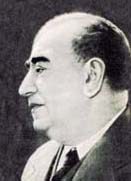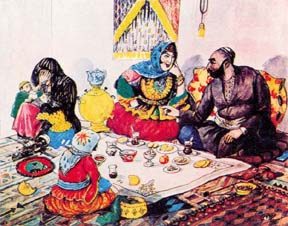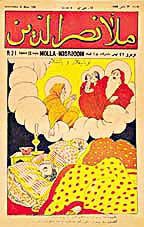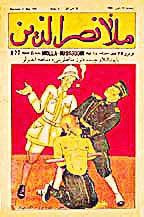|

Summer
1999 (7.2)
Pages
28-30
Azim Azimzade
(1880-1943)
Baku's Art
School Named After Self-Taught Artist
by Ziyadkhan Aliyev
Visit AZgallery.org for more works of Azim Azimzade
 Azim Azimzade
is often referred to as the "Sabir" of Azerbaijani
art. Just as Sabir (1862-1911) was famous for writing sharp satire
on social issues in the early 20th century, Azimzade was famous
for illustrating these same concerns in his paintings. He often
focused on the inequalities and injustices in society-poverty,
women's rights and educational opportunities. He also scoffed
at religious traditions and often ran a "one-man campaign"
against what he considered to be superstitious thinking. Azim Azimzade
is often referred to as the "Sabir" of Azerbaijani
art. Just as Sabir (1862-1911) was famous for writing sharp satire
on social issues in the early 20th century, Azimzade was famous
for illustrating these same concerns in his paintings. He often
focused on the inequalities and injustices in society-poverty,
women's rights and educational opportunities. He also scoffed
at religious traditions and often ran a "one-man campaign"
against what he considered to be superstitious thinking.
Azim Azimzade
was born April 30, 1880 in Novkhani village near Baku. Here the
men were involved in farming, sheep raising, vineyard and mulberry
cultivation while the women were famous as carpet-weavers. Azim's
father Aslan was a farmer and stone cutter but after the oil
industry began to boom, he joined the rush of laborers flooding
Baku to work in the oil fields.
Of five children (four girls and a boy), Azim was the only child
in his family to survive past the age of ten.
When he was eight years old, his father enrolled him in the local
Muslim school (madrasa), but the child soon ran into difficulties.
Once while the Koran was being recited (in Arabic), Azim was
absorbed in making sketches instead of paying attention. As a
consequence of his "sinful deed" (as the mollas called
it), the child was severely beaten. The incident embittered him,
and he spent the rest of his life fighting what he considered
to be unreasonable practices associated with religion.
Artwork by
Azimzade.
Covers of Molla Nazraddin, a satiric magazine, all 1928. (Left)
Telling God not to wake the sleepers for prayers because they
will only ask for 1,000 angels. (Center) Workers oblivious to
the most religious Muslim holiday. (Right) British official approving
of Japanese mistreatment of Chinese.
With the assistance of his grandmother (but unknown to his father
who was a deeply religious man), Azim started attending a secular
school where both Russian and Azeri were taught. It was here
that he was encouraged to illustrate fairytales with watercolors
and where he got his first introduction to art. He finished primary
school but was unable to pursue further education because his
father insisted that he start working. He was 15 years old at
the time. Azimzade wrote: "From early childhood, I became
a wage earner, working as a messenger or shop assistant. Only
in my spare time was I able to draw or educate myself."
Art: Azim Azimzade. "The
Old Wife and the New One", 1935.
 While working as an errand boy in the
mill of merchant Agabala Guliyev, Azim became acquainted with
the Russian painter Durov, who happened to be involved with decorating
Guliyev's newly built house at the time. Azim was invited to
help the painter decorate the interior walls with oil paintings.
Durov recognized Azim's talent and encouraged him to study painting.
But the problem was money. When Azim approached a wealthy landowner
to assist him in going to art school, the man scoffed. "Wake
up!" he told him. "Go choose another profession. We
need engineers, not painters." Thus, Azim never received
any formal instruction in art. Nevertheless, he managed to build
his career as an artist. While working as an errand boy in the
mill of merchant Agabala Guliyev, Azim became acquainted with
the Russian painter Durov, who happened to be involved with decorating
Guliyev's newly built house at the time. Azim was invited to
help the painter decorate the interior walls with oil paintings.
Durov recognized Azim's talent and encouraged him to study painting.
But the problem was money. When Azim approached a wealthy landowner
to assist him in going to art school, the man scoffed. "Wake
up!" he told him. "Go choose another profession. We
need engineers, not painters." Thus, Azim never received
any formal instruction in art. Nevertheless, he managed to build
his career as an artist.
In 1914, Azimzade published his first major work to accompany
Sabir's satirical verses in a volume called "Hop-Hop Name"
(The "Shush-Shush Journal"-"hop" meaning
"be quiet, don't tell").
During the 1920s and 1930s, he worked with various newspapers
and magazines, managing to get one of his caricatures published
in the satiric magazine, "Molla Nasraddin" (1906-1931).
Eventually, he was named its Head Artist.
In the 1920s, Azim devoted considerable time to illustrating
literary works-especially short stories by Akhundov, Mammadgulizade,
Narimanov, Shaig, Vazi and others. In 1923 when Azerbaijan celebrated
its 50th Jubilee for Dramatic Works, Azim had been assigned as
chief artist for the State Theater and responsible for organizing
the set designs of numerous works including "Haji Gara",
"Nadir Shah", "Othello", "Leyli and
Majnun" and others. In 1927 Azim was honored as "People's
Artist of Azerbaijan"-the first artist ever to receive this
award.
Criticizing Society
The
most fruitful period of Azim's creative activity took place during
the 1930s when he dedicated works to the old Azerbaijani traditions
and customs. Well-known works during this period include "Ram
Fight," "Kos-Kosa,"(a clown-like character at
Noruz spring festivities), "Tight-Rope Walker," (a
tradition at Noruz) and "Dog Fight." In addition, he
worked on a series called "Old Baku".
In his attempt to expose the inequalities of the society, he
often developed contrastive scenes comparing wealth with poverty,
as well as societal attitudes towards men and women. For example,
he drew "Wealthy Wedding" and "Poor Wedding"
(1931). In both paintings, the scene features the woman's celebration
of the wedding. In the rich home, a large bright room is crowded
with women wearing elaborate dresses and dancing. One woman plays
an accordion, another the "gaval" (like a tambourine).
Everyone is clapping to the rhythm of the music. The carpeted
floor is laid with trays of candles and sugar cones (a traditional
symbol of abundance).
But at the poor people's celebration, the room is small and quite
dark, lit by one small lantern. The peasants wear what seems
to be their everyday clothes. Even a few men are present at the
lively festivities.
Another paired theme was "Ramazan of the Rich" and
"Ramazan of the Poor" (1938). (Ramazan identifies the
month of fasting on the Islamic calendar. Customarily, Muslims
fast from sunrise to sunset, refraining from eating, smoking
and even drinking water. But at night, they enjoy elaborate dinners
where it's not uncommon for them to make up for the rest of the
day by gorging themselves.)
Once again, the rich man's home is bright and ornate; food is
plentiful on the "sufra" (tablecloth spread on the
carpeted floor) and even the cat is eating from its own bowl.
In the poor man's home, the room is dark and there is no furniture.
Bed covers are stacked in a niche in the wall of the one room
that serves for living, dining and sleeping. The plates are nearly
empty on the "sufra" and a cat with a forlorn expression
appears in the center foreground staring out in misery at the
viewer.
Azim also employed single scenes to describe contrastive situations
as in the painting called "Division of Property" (1935)
where a woman completely shrouded in black veil has been allocated
five tokens, whereas the man (her husband) has twice that amount.
In the center of the painting is a fat, turbaned Molla with his
finger pointing to the section of the Koran that authorizes such
division.
Women's Rights
Many
of his paintings expose the harsh conditions imposed on women.
Works like "The Girl Married Off Against Her Will,"
"Husband Beating His Wife," (1937) and "Difficult
Labor" show the  hardships
that women faced. In his painting "The Old Wife and the
New One," (1935) Azimzade shows a plump, colorfully dressed
woman enjoying tea with her husband, while another woman (obviously
the "first wife") veiled in black, crouches in the
corner hiding her face in her hands, her crying infant leaning
against her. hardships
that women faced. In his painting "The Old Wife and the
New One," (1935) Azimzade shows a plump, colorfully dressed
woman enjoying tea with her husband, while another woman (obviously
the "first wife") veiled in black, crouches in the
corner hiding her face in her hands, her crying infant leaning
against her.
Another scene is entitled, "A Daughter is Born" (1937).
A man and older woman, obviously disappointed that the infant
has not turned out to be a boy, are shown with their backs turned
on the wife in bed and her assisting midwife.
Some of Azim's drawings are signed with the initials "AA"
either in the Arabic script (ain-ain) or with the "upside
down e," a letter used in both the early Latin script (1928-1937)
and Cyrillic which followed afterwards. On other occasions, he
adopted an assumed name to protect his identity. Often, he did
not sign his works at all, especially on those he knew to be
provocative.
Religious Caricatures
Azim was known for caricaturing religious authorities. But there
was a price to be paid: his house was located right next to a
mosque. The mollas reportedly situated the mosque's toilet so
that the stench would fill Azim's house.
According to academician and "People's Artist" Mikayil
Abdullayev, Azim used to retaliate by painting caricatures of
mollas on pieces of paper and scattering them in front of the
mosque each evening. Sometimes Abdullayev would "steal"
those caricatures in order not to let them fall into the mollas'
hands, knowing they would be immediately shredded to pieces.
Azim's first personal exhibition was organized in Baku in 1940
and included 1,200 works, representing 35 years of creative activity.
That same year, exhibitions of his works were organized in Moscow
and Yerevan.
A Close Call
Even though Azim had been very supportive of the Communist Revolution,
he himself was targeted in 1937 (the year known as Stalin's Repression).
During that period, "black ravens", or "one-eyed
cars", would stop in front of homes in the middle of the
night and arrest people. ("One-eyed" refers to the
fact that one headlight was turned off so that other vehicles
would give them the right-of-way.)
One night, one of these cars stopped in front of Azim's house
and he was arrested, allegedly for cursing Lenin and Stalin.
Azim insisted that he was a Communist Party member and that he
had been slandered. (It was later learned that a former apprentice
had turned him in.) Only after intervention by Mirjafar Bagirov,
First Secretary of the Communist Party of Azerbaijan and familiarly
known as the "local Stalin", was he released.
Azim had five children. He was especially fond of his son Latif
(1924-1943), who became an oil engineer. Latif was called up
to serve in World War II. His last letter home was dated February
1943. Azim was devastated when he received the news of his death
and never recovered. He died of a heart attack on June 15, 1943,
exactly four months later.
Since then, Baku's Art School, which Azimzade had directed from
1928-1938, was named after him. Most of Azerbaijan's greatest
artists have received training in this institution. They tribute
Azim as being one of the first major artists in their country
and for his social conscience.
Azim Azimzade's
Home Museum is located at 157 Dilara Aliyeva Street in Baku.
His daughter Zahra is Director of the Museum. Tel: (99-412) 94-05-69.
From
Azerbaijan
International
(7.2) Summer1999.
© Azerbaijan International 1999. All rights reserved.
Back to Index
AI 7.2 (Summer 99)
AI Home
| Magazine
Choice | Topics
| Store
| Contact
us
|

 Azim Azimzade
is often referred to as the "Sabir" of Azerbaijani
art. Just as Sabir (1862-1911) was famous for writing sharp satire
on social issues in the early 20th century, Azimzade was famous
for illustrating these same concerns in his paintings. He often
focused on the inequalities and injustices in society-poverty,
women's rights and educational opportunities. He also scoffed
at religious traditions and often ran a "one-man campaign"
against what he considered to be superstitious thinking.
Azim Azimzade
is often referred to as the "Sabir" of Azerbaijani
art. Just as Sabir (1862-1911) was famous for writing sharp satire
on social issues in the early 20th century, Azimzade was famous
for illustrating these same concerns in his paintings. He often
focused on the inequalities and injustices in society-poverty,
women's rights and educational opportunities. He also scoffed
at religious traditions and often ran a "one-man campaign"
against what he considered to be superstitious thinking.


 While working as an errand boy in the
mill of merchant Agabala Guliyev, Azim became acquainted with
the Russian painter Durov, who happened to be involved with decorating
Guliyev's newly built house at the time. Azim was invited to
help the painter decorate the interior walls with oil paintings.
Durov recognized Azim's talent and encouraged him to study painting.
But the problem was money. When Azim approached a wealthy landowner
to assist him in going to art school, the man scoffed. "Wake
up!" he told him. "Go choose another profession. We
need engineers, not painters." Thus, Azim never received
any formal instruction in art. Nevertheless, he managed to build
his career as an artist.
While working as an errand boy in the
mill of merchant Agabala Guliyev, Azim became acquainted with
the Russian painter Durov, who happened to be involved with decorating
Guliyev's newly built house at the time. Azim was invited to
help the painter decorate the interior walls with oil paintings.
Durov recognized Azim's talent and encouraged him to study painting.
But the problem was money. When Azim approached a wealthy landowner
to assist him in going to art school, the man scoffed. "Wake
up!" he told him. "Go choose another profession. We
need engineers, not painters." Thus, Azim never received
any formal instruction in art. Nevertheless, he managed to build
his career as an artist.